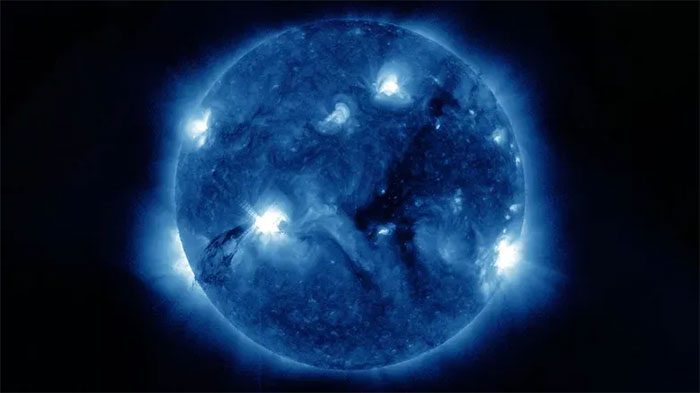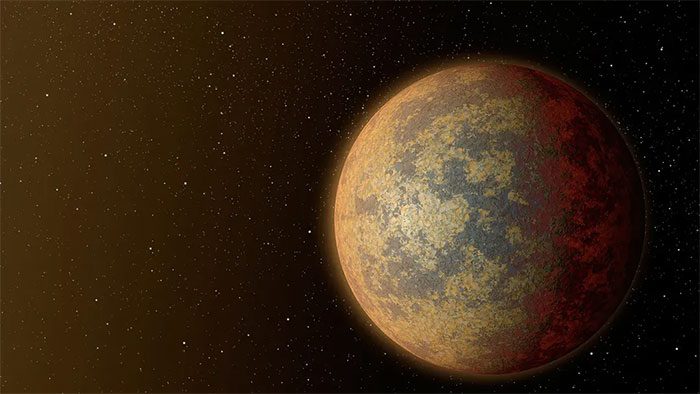Theoretically, strange matter is produced after a star dies. So what happens when a star dies?
The answer completely depends on the mass of the star. Over time, every star, including our Sun, will gradually cool down and eventually become a white dwarf. However, some stars have a more dramatic end; they collapse rapidly due to low pressure within the star’s core, leading to cosmic explosions known as supernovae.

Our Sun is about 330,000 times larger than Earth. (Illustrative image).
Supernovae are also responsible for creating black holes scattered throughout the galaxy, but the prerequisite is that the stars must have a mass at least three times that of the Sun before they explode. To put this in perspective, our Sun is approximately 330,000 times larger than Earth.
The nuclear fusion process in the core of a star keeps gravitational forces from compressing the mass inward. When a star’s hydrogen supply is depleted, the nuclear fusion process becomes unsustainable. At this point, gravitational collapse occurs when the pressure inside the object is no longer sufficient to counteract its own gravitational pull, potentially transforming the remaining core of the star into a black hole.
The second possibility is that if the core is solid enough to withstand gravitational forces, the remaining electrons and protons will combine to form neutrons, creating a neutron star. Unlike black holes, from which light cannot escape, neutron stars can still be seen with the naked eye. However, in another direction, the subatomic quarks inside the neutron star—which are responsible for holding everything together—can become uncontrollable, ultimately causing phenomena that defy conventional nuclear physics.
Most subatomic particles (components of atoms) are made up of a tightly bound combination of three fundamental quarks (two up quarks and one down quark), also known as hadrons. In most cases, quarks tend to be inseparable, but this cannot be guaranteed inside a neutron star, where quarks, due to extreme pressure, may exist in a “soup” state—allowing up and down quarks to move freely.
In 2004, a team of researchers at Cornell University hypothesized that conditions inside a neutron star could produce hyperons, a type of particle that includes strange quarks—quarks so perfect at the atomic level that they can easily convert normal quarks into strange quarks, leading to strange matter.
 A neutron star successfully transforming itself into strange matter is called a strange quark star.
A neutron star successfully transforming itself into strange matter is called a strange quark star.
Strange matter not only has the ability to absorb any particles it comes into contact with, pulling many quark particles into the quark “soup,” but it can also escape the core of the neutron star while maintaining its nature. According to researchers, it has the potential to transform entire stars and planets into strange matter, thereby creating “strange” planets and white dwarfs. A neutron star that successfully transforms itself into strange matter is referred to as a strange quark star.
In 2019, Cornell University reported that the primary dispersion of strange matter from a strange quark star in the form of fragmented rings could occur during collisions between one or more strange quark stars. The result of this dispersion would be the emergence of many strangelets (also known as annihilation particles), drifting through the universe. These strangelets could transform the nucleus of any atom into a strangelet upon contact, leading to a chain reaction where these strangelets act like a virus, corroding all other atoms and converting everything into strangelets until nothing remains but these strangelets.
The research team hypothesized that if just one strangelet were to approach Earth’s atmosphere, its strange nature would convert everything on Earth into strange matter. If you cannot imagine this, the process would instantly kill all life on the blue planet.
However, there’s no need to worry too much; the journal Nature published a report in 2017 indicating that strangelets could be as theoretical as dark matter, which is believed to make up about 70% of the universe’s mass (dark matter + ordinary matter). If strange matter is indeed continuously surrounding the universe, the number of strange planets and strange stars must significantly increase due to its “corrosive” nature. But currently, science has not discovered any alarming figures, so humanity seems to remain safe for a long time to come.





















































